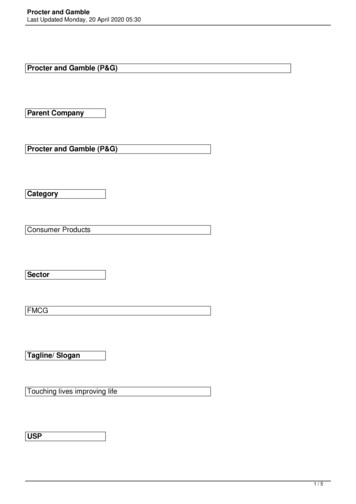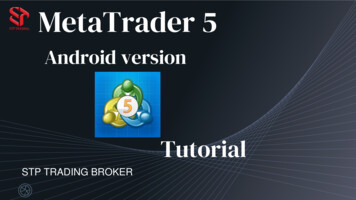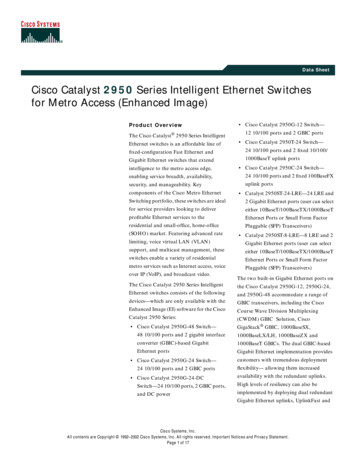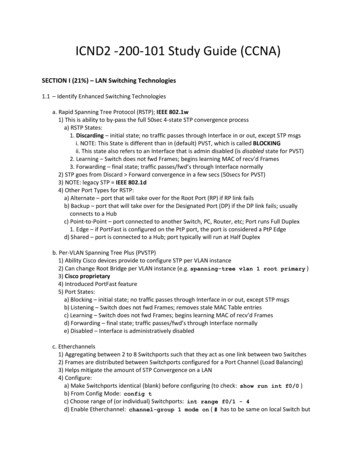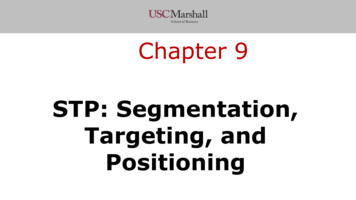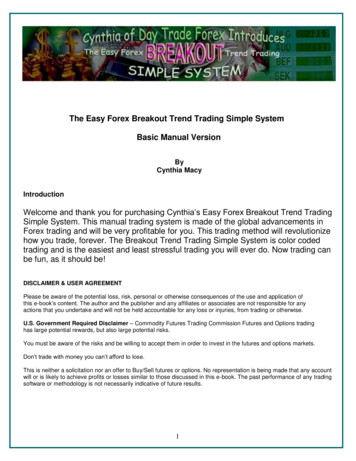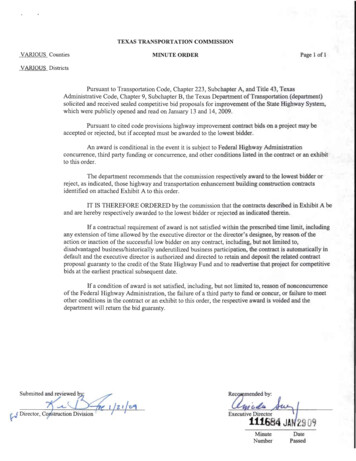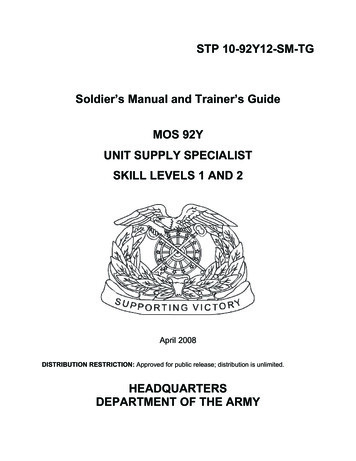
Transcription
STP 10-92Y12-SM-TGSoldier’s Manual and Trainer’s GuideMOS 92YUNIT SUPPLY SPECIALISTSKILL LEVELS 1 AND 2April 2008DISTRIBUTION RESTRICTION: Approved for public release; distribution is unlimited.HEADQUARTERSDEPARTMENT OF THE ARMY
This publication is available atArmy Knowledge Online (www.us.army.mil)and the General Dennis J. ReimerTraining and Doctrine Digital Library at(www.train.army.mil)
*STP 10-92Y12-SM-TGSOLDIER TRAININGPUBLICATIONNo. 10-92Y12-SM-TGHEADQUARTERSDEPARTMENT OF THE ARMYWashington, D.C., 30 April 2008SOLDIER'S MANUAL and TRAINER'S GUIDEMOS 92YUnit Supply SpecialistSkill Levels 1 and 2CONTENTSPAGEPreface . ivChapter 1. Introduction. 1-11-1. General. 1-11-2. Task Summaries . 1-11-3. Soldier’s Responsibilities. 1-21-4. NCO Self-Development and the STP. 1-21-5. Commander’s Responsibilities. 1-21-6. Trainer’s Responsibilities .1-31-7. Training Support. 1-3Chapter 2. MOS Training Plan . 2-12-1. General. 2-12-2. Subject Area Codes .2-22-3. Duty Position Training Requirements. 2-22-4. Critical Tasks List . 2-3DISTRIBUTION RESTRICTION: Approved for public release; distribution is unlimited.*This publication supersedes STP 10-92Y12-SM-TG, 13 March 2003.30 April 2008i
STP 10-92Y12-SM-TGPAGEChapter 3. MOS/Skill Level Tasks . 3-1Skill Level 01-92Y-1015Subject Area 1: Basic SupplyAccount for Property . 3-1Maintain Required Publications . 3-5Maintain Unit Supply Files .3-8Prepare Delegation of Authority Documents .3-13Prepare a Document Register -92Y-1125Subject Area 2: Supply ProceduresRequest Supplies and Equipment.3-20Request Cancellation of Supplies .3-31Receive Property.3-35Issue Property .3-38Process Hand Receipts/Subhand Receipts .3-41Store Property .3-50Inventory Property.3-56Turn-In Property/Army Assets.3-60Perform Lateral Transfer of Property .3-64Process Property Adjustment Documents .3-71Maintain Unit Loads .3-79Perform Unit Logistics System Set Up.3-83Update Parameter Tables.3-88Update Organizational Data.3-91Perform Catalog Maintenance .3-95Update Component Data .3-99Perform Ammunition Transactions.3-102Subject Area 3: Organizational Clothing Procedures101-92Y-1205 Process Personal Clothing Request .3-112101-92Y-1206 Prepare Organizational Clothing and Individual Equipment (OCIE) Record .3-114101-92Y-1207 Process Organizational Laundry.3-122Subject Area 4: Arms Room Procedures101-92Y-1301 Control Weapons and Ammunition in the Arms Room .3-124101-92Y-1409 Perform Organizational (Unit) Maintenance on Small Arms .3-131Skill Level 2Subject Area 5: Filing Procedures101-92Y-2001 Review Unit Supply Files 2103101-92Y-2104iiSubject Area 6: Property Book ProceduresSupervise the Inventory of Property.3-144Post Transaction to Property Book .3-146Manage Hand Receipts/Subhand Receipts .3-153Maintain Authorizations.3-157Process a Lateral Transfer of Property .3-16030 April 2008
STP 10-92Y12-SM-TGPAGESubject Area 7: Absentee Property Accountability Procedures101-92Y-2201 Account for Absentee's Clothing, Equipment, and Personal Effects .3-162101-92Y-2202 Determine Disposition of Absentee's Clothing, Equipment, and PersonalEffects .3-164Subject Area 8: Relief from Property Responsibility Procedures101-92Y-2003 Obtain Relief From Responsibility for Property.3-167Chapter 4. Duty Position Tasks . 4-1Appendix A. Hands-On Evaluation. A-1Appendix B. Field Expedient Squad Book . B-1Glossary . Glossary-1References. References-130 April 2008iii
STP 10-92Y12-SM-TGPrefaceThis publication is for skill levels (SLs) 1 and 2 Soldiers holding military occupational specialty (MOS)92Y. It contains standardized training objectives, in the form of task summaries that you can use to trainand evaluate yourself on critical tasks that support unit missions during peacetime and wartime. Soldiersholding MOS 92Y and SL 1 and 2 should have access to this publication. It should be made available inwork areas, unit learning centers, and installation MOS libraries.All tasks in this publication are trained to peacetime/wartime conditions and apply to the Active Army, theArmy National Guard/Army National Guard of the United States, and the US Army Reserve unlessotherwise stated.The proponent of this publication is the United States Army Training and Doctrine Command(USATRADOC). Prepare comments and recommendations using DA Form 2028(Recommended Changes to Publications and Blank Forms) and forward them directly to—Department of the ArmyTraining Directorate, Sustain DivisionATTN: ATCL-TDS401 First StreetFort Lee, Virginia 23801-1511iv30 April 2008
STP 10-92Y12-SM-TGChapter 1Introduction1-1. General. This Soldier Training Publication (STP) identifies individual MOS training requirements forSoldiers holding MOS 92Y. Commanders, trainers, and Soldiers should use it to plan, conduct, andevaluate individual training in units. The STP is the primary MOS reference for supporting selfdevelopment, evaluating MOS proficiency, and training of 92Y Soldiers. Commanders employ twoprimary methods to evaluate Soldiers’ proficiency: Commander's evaluation. Commander’s evaluations are local tests or assessments ofSoldiers' performance of MOS-specific and common tasks critical to the unit mission. They maybe conducted year-round. Common task test (CTT). CTTs are hands-on tests used to evaluate proficiency on commontasks. Alternate written tests are provided if equipment is not available for hands-on testing.This publication is the Soldier's primary reference to prepare for a commander's evaluation of MOSspecific tasks. It contains task summaries for all critical tasks specific to the MOS and skill level (SL).Commanders and trainers will use this Soldier's Manual/Trainer's Guide (SM/TG) to plan and conducttraining and commander's evaluations. Chapter 2, Trainer’s Guide, contains information needed to plantraining requirements for this MOS. The trainer's guide Identifies subject areas in which Soldiers must be trained. Identifies critical tasks for each subject area. Specifies where Soldiers are initially trained on each task. Recommends how often each task should be trained to sustain proficiency. Recommends a strategy for cross-training Soldiers. Recommends a strategy for training Soldiers to perform higher-level tasks.Use this STP along with STP 21-1-SMCT (Soldier’s Manual of Common Tasks, Skill Level 1),STP 21-24-SMCT (Soldier’s Manual of Common Tasks (SMCT) Warrior Leader Skill Levels 2-4),Army training and evaluation programs (ARTEPs), FM 25-4 (How to Conduct Training Exercises),FM 25-5 (Training for Mobilization and War), FM 7-0 (Training the Force), and FM 7-1 (Battle FocusedTraining) to establish effective training plans and programs that integrate Soldier, leader, and collectivetasks.1-2. Task Summaries. Task summaries outline wartime performance requirements for each critical taskin the STP. They provide both Soldier and trainer with the information necessary to prepare, conduct,and evaluate critical task training. As a minimum, task summaries include information Soldiers mustknow and skills they must perform to standard for each task. Following is the task summary format: Task number. The task number is a 10-digit number that identifies the task and SL. Includethe task number and title in any correspondence relating to the task. Task title. The task title identifies the action to be performed. Conditions. The task conditions statement describes the field or garrison conditions underwhich the task will be performed and identifies the equipment, tools, references, job aids, andsupporting personnel that the Soldier needs to perform the task in wartime.30 April 20081-1
STP 10-92Y12-SM-TG Standards. The task standards describe how well and to what level of proficiency the Soldiermust perform the task under wartime conditions. Standards are typically expressed in terms ofaccuracy, completeness, duration, sequence, speed, and tolerance. Performance steps. This section provides, in detail, what is required on how to perform thetask. Performance measures. This section identifies specific actions that the Soldier mustaccomplish to complete the task successfully. Performance measures appear in a GO/NO-GOrating format for easy evaluation. Some tasks may also include detailed training information in aTraining Information Outline and an Evaluation Preparation Section. The Evaluation PreparationSection indicates necessary modifications to task performance in order to train and evaluate atask that cannot be trained to the wartime standard under wartime conditions. It may also includespecial training and evaluation preparation instructions to accommodate these modifications andany instructions that should be given to the Soldier before evaluation. References. This section identifies references that provide more detailed explanations oftask performance requirements than are given in the task summary. Warnings. Warnings alert users to the possibility of immediate personal injury or equipmentdamage. Notes. Notes provide additional supportive explanations or tips relating to task performance.1-3. Soldier’s Responsibilities. Each Soldier is responsible for performing individual tasks identified bythe first-line supervisor based on the unit’s mission-essential task list (METL). Soldiers must performtasks to the standards included in the task summary. If Soldiers have questions about tasks or whichtasks in this manual they must perform, they are responsible for asking their first-line supervisor forclarification. First-line supervisors know how to perform each task or can direct Soldiers to appropriatetraining materials, including current field manuals, technical manuals, and Army regulations. Soldiers areresponsible for using these materials to maintain performance. They are also responsible for maintainingperformance of all common tasks listed in the SMCTs at their current SL and below. Periodically,Soldiers should ask their supervisor or another Soldier to check their performance to ensure that they canperform the tasks.1-4. NCO Self-Development and the STP. Self-development is a key component of leader development.Leaders follow planned, progressive, sequential self-development programs developed by the individualNCO and his or her first-line supervisor to enhance and sustain military competencies. Self-developmentconsists of individual study, research, professional reading, practice, and self-assessment. The selfdevelopment concept requires all NCO, as Army professionals, to take responsibility for remaining currentin all phases of their MOS. The STP is the NCO primary source for maintaining MOS proficiency.Another important resource for self-development is the Army Correspondence Course Program (ACCP).For enrollment information in this program, visit on line through the Army Institute for ProfessionalDevelopment (AIPD) website at http://www.atsc.army.mil/accp/aipdnew.asp.1-5. Commander’s Responsibilities. Commanders must ensure that their unit training plans prepare theunit for war by enabling Soldiers to develop and sustain proficiency in their MOS and SL tasks.Commanders should design unit training programs to provide individual training for all Soldiers assignedto the unit and to evaluate Soldier proficiency routinely as part of the commander’s evaluation program.The unit training program should also integrate individual training with crew drills and other collectivetraining. The MOS training plan provides information on which to base integration, cross-train, train-up,and sustainment training programs. Commanders should use the MOS training plan when developingunit training plans.1-230 April 2008
STP 10-92Y12-SM-TG1-6. Trainer’s Responsibilities. Training is the business of all unit leaders. First-line leaders are theprincipal trainers in the unit because they directly supervise Soldiers and lead crews, squads, sections,and teams.a.Trainers can use the MOS training plan to determine the critical tasks each Soldier isresponsible for. They should tell each Soldier which tasks he or she must be able to perform. Trainersshould evaluate task performance to determine which tasks each Soldier can or cannot perform tostandard. Soldiers who cannot perform a task to standard need further training. Developing effectivetraining is explained in detail in FM 7-0 and FM 7-1.b.Every task summary in this STP includes performance measures, which trainers may useyear-round to determine if Soldiers can perform critical tasks to the specified standards. The performancemeasures identify what the trainer needs to observe to score a Soldier’s performance. A blank space isprovided for the trainer to check either the GO or NO-GO column for each performance measure. Sometasks require the trainer to watch the Soldier perform them (evaluate the process). Other tasks call for thetrainer to focus on the results of the Soldier’s performance (evaluate the product). Comments should notbe written on the task summary.c.Trainers can monitor the progress of their Soldiers by recording task GO/NO-GO results.Trainers may use DA Form 5164-R (Hands-On Evaluation) to record the performance measures a Soldierpassed or failed. The form, which may be locally reproduced, applies to all tasks in this STP. Trainersmay have DA Form 5164-R overprinted with information unique to their training requirements beforereproducing it. See Appendix A for instructions on how to obtain and fill out a copy of a DA Form 5164-R.d.Trainers may use DA Form 5165-R (Field Expedient Squad Book) to record hands-onGO/NO-GO results for a group of Soldiers (for example, a crew, section, or squad) having the same MOSand SL. This form supports conduct of commander’s evaluations and can be used to record trainingresults gathered in the field during slack time for all MOSs and SLs. Use of this form is optional. SeeAppendix B for instructions on how to obtain and fill out a copy of a DA Form 5165-R. Trainers shouldwork with each Soldier until tasks can be performed to specific task summary standards.1-7. Training Support. References have been identified for each task to assist in planning andconducting training. A consolidated list of references identified by type, publication number, and title anda comprehensive glossary of acronyms, abbreviations, and definitions are included in this STP.30 April 20081-3
THIS PAGE INTENTIONALLY LEFT BLANK
STP 10-92Y12-SM-TGChapter 2MOS Training Plan2-1. General. The MOS Training Plan identifies the essential components of a unit training plan forindividual training. Units have different training needs and requirements based on differences inenvironment, location, equipment, dispersion, and similar factors. Therefore, the MOS Training Planshould be used as a guide for conducting unit training and not a rigid standard. The MOS Training Planconsists of two parts. Each part is designed to assist the commander in preparing a unit training planwhich satisfies integration, cross training, training up, and sustainment training requirements for Soldiersin this MOS.Part One of the MOS Training Plan shows the relationship of an MOS SL between duty position andcritical tasks. These critical tasks are grouped by task commonality into subject areas.Section I lists subject area numbers and titles used throughout the MOS Training Plan. These subjectareas are used to define the training requirements for each duty position within an MOS.Section II identifies the total training requirement for each duty position within an MOS and provides arecommendation for cross training and train-up/merger training. Duty Position Column. This column lists the duty positions of the MOS, by SL, which have differenttraining requirements. Subject Area Column. This column lists, by numerical key (see Section I), the subject areas aSoldier must be proficient in to perform in that duty position. Cross-Train Column. This column lists the recommended duty position for which Soldiers should becross-trained. Train-Up/Merger Column. This column lists the corresponding duty position for the next higher SL orMOSC the Soldier will merge into on promotion.Part Two lists, by general subject areas, the critical tasks to be trained in an MOS and the type of trainingrequired (resident, integration, or sustainment). Subject Area Column. This column lists the subject area number and title in the same order asSection I, Part One of the MOS Training Plan. Task Number Column. This column lists the task numbers for all tasks included in the subject area. Title Column. This column lists the task title for each task in the subject area. Training Location Column. This column identifies the training location where the task is first trainedto Soldier training publications standards. If the task is first trained to standard in the unit, the word“Unit” will be in this column. If the task is first trained to standard in the training base, it will identify, bybrevity code (for example ANCOC, BNCOC, and so on), the resident course where the task wastaught. Figure 2-1 contains a list of training locations and their corresponding brevity codes.AITANCOCBNCOCUNITAdvanced Individual TrainingAdvanced Noncommissioned Officer CourseBasic Noncommissioned Officer CourseTrained in the UnitFigure 2-1. Training Locations30 April 20082-1
STP 10-92Y12-SM-TG Sustainment Training Frequency Column. This column indicates the recommended frequency atwhich the tasks should be trained to ensure Soldiers maintain task proficiency. Figure 2-2 identifiesthe frequency codes used in this lyQuarterlyMonthlyBiweeklyWeeklyFigure 2-2. Sustainment Training Frequency Codes Sustainment Training Skill Level Column. This column lists the SLs of the MOS for which Soldiersmust receive sustainment training to ensure they maintain proficiency to Soldier’s manual standards.2-2. Subject Area Codes.Skill Level 11Basic Supply2Supply Procedures3Organizational Clothing Procedures4Arms Room ProceduresSkill Level 25Filing Procedures6Property Book Procedures7Absentee Property Accountability Procedures8Relief from Property Responsibility Procedures2-3. Duty Position Training Requirements.MOS TRAINING PLAN92YPART ONESECTION II. DUTY POSITION TRAINING REQUIREMENTSDuty PositionSubjectAreasCrossTrainTrain-up/MergerSL 1Unit Supply Specialist1-43-4Unit Supply SergeantS-4 NCOICSL 2Unit Supply Specialist5-83-4Unit Supply SergeantS-4 NCOIC2-230 April 2008
STP 10-92Y12-SM-TG2-4. Critical Tasks List.MOS TRAINING PLAN92Y12CRITICAL TASKSTask NumberTitleTrainingLocationSustTngFreqSustTng SLSkill Level 1Subject Area 1. Basic Supply101-92Y-1011Account for PropertyAITQT1101-92Y-1012Maintain Required PublicationsAITQT1101-92Y-1013Maintain Unit Supply FilesAITQT1101-92Y-1014Prepare Delegation of Authority DocumentsAITQT1101-92Y-1015Prepare a Document RegisterAITQT1Subject Area 2. Supply Procedures101-92Y-1016Request Supplies and EquipmentAITQT1101-92Y-1017Request Cancellation of SuppliesAITQT1101-92Y-1018Receive PropertyAITQT1101-92Y-1019Issue PropertyAITQT1101-92Y-1020Process Hand Receipts/Subhand ReceiptsAITQT1101-92Y-1021Store PropertyAITQT1101-92Y-1022Inventory PropertyAITQT1101-92Y-1023Turn-In Property/Army AssetsAITQT1101-92Y-1024Perform Lateral Transfer of PropertyAITQT1101-92Y-1025Process Property Adjustment DocumentsAITQT1101-92Y-1026Maintain Unit LoadsAITQT1101-92Y-1120Perform Unit Logistics System Set UpAITQT1101-92Y-1121Update Parameter TablesAITQT1101-92Y-1122Update Organizational DataAITQT1101-92Y-1123Perform Catalog MaintenanceAITQT1101-92Y-1124Update Component DataAITQT1101-92Y-1125Perform Ammunition TransactionsAITQT1Subject Area 3. Organizational Clothing Procedures101-92Y-1205Process Personal Clothing RequestAITQT1101-92Y-1206Prepare Organizational Clothing and Individual Equipment(OCIE) RecordAITQT1101-92Y-1207Process Organizational LaundryUNITQT1Subject Area 4. Arms Room Procedures101-92Y-1301Control Weapons and Ammunition in the Arms RoomAITQT1101-92Y-1409Perform Organizational (Unit) Maintenance on Small ArmsAITQT130 April 20082-3
STP 10-92Y12-SM-TGCRITICAL TASKSTask NumberTitleTrainingLocationSustTngFreqSustTng SLAITQT1/2AITQT1/2Skill Level 2Subject Area 5. Filing Procedures101-92Y-2001Review Unit Supply FilesSubject Area 6. Property Book Procedures101-92Y-2002Supervise the Inventory of Property101-92Y-2101Post Transaction to Property BookAITQT1/2101-92Y-2102Manage Hand Receipts/Subhand ReceiptsAITQT1/2101-92Y-2103Maintain AuthorizationsAITQT1/2101-92Y-2104Process a Lateral Transfer of PropertyAITQT1/2Subject Area 7. Absentee Property Accountability Procedures101-92Y-2201Account for Absentee's Clothing, Equipment, andPersonal EffectsAITQT1/2101-92Y-2202Determine Disposition of Absentee's Clothing,Equipment, and Personal EffectsAITQT1/2AITQT1/2Subject Area 8. Relief from Property Responsibility Procedures101-92Y-20032-4Obtain Relief From Responsibility for Property30 April 2008
STP 10-92Y12-SM-TGChapter 3MOS/Skill Level TasksSkill Level 1Subject Area 1: Basic SupplyAccount for Property101-92Y-1011Conditions: Assigned as a unit supply specialist, in a field or garrison environment, and given therequirement to account for unit property. Given the units current authorization documents to includeCTA 50-900, CTA 50-909, Modified Table of Organization and Equipment (MTOE), Tables of Distributionand Allowance (TDA), and Joint Table of Allowances (JTA).Standards: Account for 100 percent of unit property.Performance Steps1. Account for Class I property. (References: DA Pamphlet 30-22, Chapter 4, paragraphs 4-6 through4-12)a. Identify Class I property.(1) Operational Loads.(2) Basic Loads.b. Account for Operational and Basic Loads.(1) Receipt of Operational and Basic Loads.(2) Storage of Operational and Basic Loads.(3) Issue Operational and Basic Loads.(4) Turn-in Operational and Basic Loads.c. Account for lost, damaged, destroyed, and inspected Class I property.2. Account for Class II property. (References: AR 710-2, Chapter 1, paragraph 1-12,DA Pamphlet 710-2-1, Chapter 4, paragraph 4-1)a. Identify Class II property.(1) Non-Expendable Property.(a) Classified.(b) Sensitive.(c) COMSEC.(2) Durable Property.(3) Expendable Property.b. Account for Non-Expendable Property.(1) Receipt of Non-expendable Property.(2) Issue Non-expendable Property.(3) Turn-in Non-expendable Property.c. Account for Durable Property.(1) Receipt of Durable Property.(2) Issue Durable Property.(3) Turn-in Durable Property.d. Account for Expendable Property.(1) Receipt of Expendable Property.(2) Issue Expendable Property.(3) Turn-in Expendable Property.e. Account for Lost, Damaged, and Destroyed Class II Property.30 April 20083-1
STP 10-92Y12-SM-TGPerformance Steps3. Account for Class III property. (References: AR 710-2, Chapter 2, paragraph 2-20)a. Identify Class III property.(1) Bulk.(2) Package Operational/Basic.b. Account for Class III Package.(1) Receipt of Class III Packaged Property.(2) Issue Class III Packaged Property.(3) Turn-in Class III Packaged Propertyc. Account for lost, damaged, and inspected Class III property.4. Account for Class IV property. (References: FM 5-116, Chapter 6, paragraph 6-1)a. Identify Class IV property.(1) Construction.(2) Barrier.b. Account for Class IV Property.(1) Receipt of Class IV property.(2) Issue Class IV property.(3) Turn-in Class IV property.c. Account for lost, damaged, and destroyed Class IV property.5. Account for Class V property. (References: DA Pamphlet 710-2-1, Chapter 7, paragraph 7-7)a. Identify Class V Property.(1) Basic Loads.(2) Operational Loads.(3) Training Loads.b. Account for Class V Basic loads.(1) Receipt of Class V Basic Loads.(2) Issue Class V Basic Loads.(3) Turn-in Class V Basic Loads.c. Account for Class V Operational loads.(1) Receipt of Class V Basic Loads.(2) Issue Class V Basic Loads.(3) Turn-In Class V Basic Loads.d. Account for Class V Training Loads.(1) Receipt of Class V Training Loads.(2) Issue Class V Training Loads.(3) Turn-in Class V Training Loads.e. Account for lost, damaged, and destroyed Class V property.6. Account for Class VI property. (References: FM 4-0, Chapter 6, paragraphs 6-34 through 6-37)a. Identify Class VI Personal Demand Items.b. Account for Class VI property.(1) Receipt of Class VI property.(2) Issue Class VI property.(3) Turn-in of Class VI property.3-230 April 2008
STP 10-92Y12-SM-TGPerformance Steps7. Account for Class VII property. (References: AR 735-5, Chapter 7, paragraphs 7-1 through 7-7)a. Identify Class VII property.(1) Non-expendable.(a) Classified.(b) Sensitive.(c) COMSEC.(2) Durable Property.(3) Expendable Property.b. Account for Class VII Non-expendable Property.(1) Receipt of Non-expendable property.(2) Issue Non-expendable property.(3) Turn-In Non-expendable property.c. Account for Class VII durable property.(1) Receipt of durable property.(2) Issue durable property.(3) Turn-in durable property.d. Account for Class VII expendable property.(1) Receipt of expendable property.(2) Issue
*stp 10-92y12-sm-tg 30 april 2008 i soldier training headquarters publication department of th
